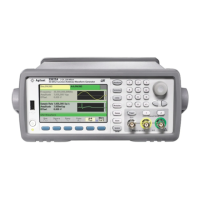Waveform Generation Tutorial
Waveform Generation Tutorial
This section describes theory of operation information for several waveform types and instrument operating modes.
The last two topics include information that may help you improve signal quality.
l Arbitrary Waveforms
l Quasi-Gaussian Noise
l PRBS
l Modulation
l Burst
l Frequency Sweep
l Attributes of AC Signals
l Signal Imperfections
l Ground Loops
Arbitrary Waveforms
Arbitrary waveforms can meet needs not met by the instrument’s standard waveforms. For example, you might need a
unique stimulus, or you might want to simulate signal imperfections such as overshoot, ringing, glitching, or noise. Arbi-
trary waveforms can be very complex, making them suitable for simulating signals in modern communications sys-
tems.
You can create arbitrary waveforms from a minimum of 8 points up to 1,000,000 points. You may also extend the
memory up to 16,000,000 points. The instrument stores these numeric data points, known as "samples," in memory
and then converts them into voltages as the waveform is generated. The frequency at which points are read is the
"sample rate," and the waveform frequency equals the sample rate divided by the number of points in the waveform.
For example, suppose a waveform has 40 points and the sample rate is 10 MHz. The frequency would be (10 MHz)/40
= 250 kHz and its period would be 4 µs.
Dual Arbitrary Waveforms
Arbitrary waveforms may be single-channel waveforms, or (with option IQP), they may be dual-channel arbitrary wave-
forms, such as IQ baseband signals. A dual arbitrary waveform is analogous to a stereo music file. It has two channels
of information that contain the same number of samples, always start and end together, and always play at the same
sample rate.
You can control the skew and balance between channels on dual arbitrary waveforms either via commands in the SCPI
FUNCtion subsystem or via the front panel.
Waveform Filters
The instrument includes two filters to smooth transitions between points as arbitrary waveforms are generated.
l Normal filter: a wide, flat frequency response, but its step response exhibits overshoot and ringing
l Step filter: a nearly ideal step response, but with more roll-off in its frequency response than the Normal filter
l Off: output changes abruptly between points, with a transition time of approximately 10 ns.
140 Agilent 33500 Series Operating and Service Guide

